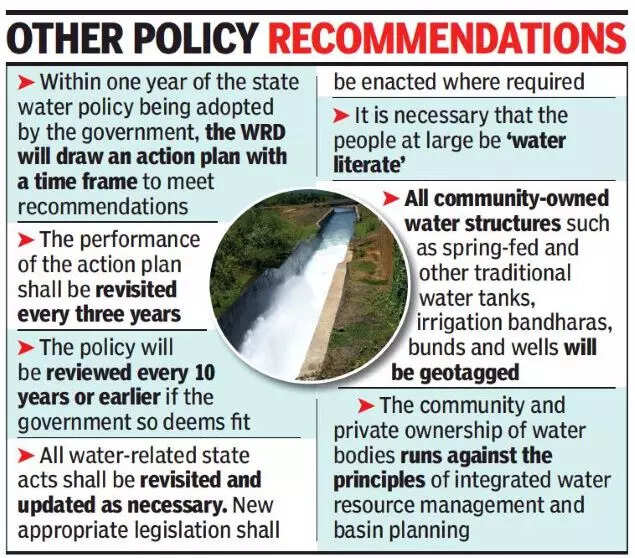Goa: Water dept’s 2021 report advises against free supply

Better planning of the resource of water is important as it is among the resources that will determine the state’s growth and development, according to the policy. (Representative image)
PANAJI: Over twenty years after Goa got its first water policy, a team under the water resources department (WRD) has drafted a revised 2021 policy document to ensure future water security for the state. The contents of the policy may, however, come as a surprise to the state government.
While chief minister Pramod Sawant recently promised 16,000 litres of free drinking water supply per month to each household, the new policy advises against providing water free of cost, calling it a resource that belongs to the community. It states that charging for water ensures its economic use as it is a resource that is linked to the state’s future growth.

“Water is a common property of the people and therefore, every user should pay for the water she/he uses, even if the user is procuring the water at her/his own cost. The state has to make considerable investment in infrastructure required to extract the water from its natural source, process it, and bring it to the user. And at least part of this expenditure should be recovered from the users,” the state water policy reads.
The document goes a step further and recommends charging consumers based on use of the volume of water in a bid to ensure its judicious use.
“Pricing of water is an instrument to bring economy to its use. A structured system of water charges on volumetric basis shall be introduced. All water charges, whether surface water or groundwater, shall be rationalised and updated periodically.”
Better planning of the resource of water is important as it is among the resources that will determine the state’s growth and development, according to the policy.
“Human requirements are not to be limited to mere subsistence. The people of Goa are proud that the state ranks number 1 in per capita GDP, and the water policy has to support maintaining this position, even improving on it,” the draft reads.
Goa adopted its first water policy in 2002, but implementation of its recommendations did not take off as expected. The new document states at the outset that it has been drafted to be “more realistic and achievable”, unlike the usual “wishful” policy documents.
The 2021 recommendations also state that the rivers of Goa, including the Mhadei, need new master plans as the existing ones are over two decades old.
“Master plans have been prepared for the Mhadei, Zuari, Galgibaga and Talpona basins. These master plans are now more than 20 years old and will have to be revisited and updated, and demand for water for all human uses will have to be reassessed for all of Goa.”
A scientific assessment of the quantity of water required for human uses and environmental needs will have to be carried out on a high priority basis, the policy states.
While chief minister Pramod Sawant recently promised 16,000 litres of free drinking water supply per month to each household, the new policy advises against providing water free of cost, calling it a resource that belongs to the community. It states that charging for water ensures its economic use as it is a resource that is linked to the state’s future growth.

“Water is a common property of the people and therefore, every user should pay for the water she/he uses, even if the user is procuring the water at her/his own cost. The state has to make considerable investment in infrastructure required to extract the water from its natural source, process it, and bring it to the user. And at least part of this expenditure should be recovered from the users,” the state water policy reads.
The document goes a step further and recommends charging consumers based on use of the volume of water in a bid to ensure its judicious use.
“Pricing of water is an instrument to bring economy to its use. A structured system of water charges on volumetric basis shall be introduced. All water charges, whether surface water or groundwater, shall be rationalised and updated periodically.”
Better planning of the resource of water is important as it is among the resources that will determine the state’s growth and development, according to the policy.
“Human requirements are not to be limited to mere subsistence. The people of Goa are proud that the state ranks number 1 in per capita GDP, and the water policy has to support maintaining this position, even improving on it,” the draft reads.
Goa adopted its first water policy in 2002, but implementation of its recommendations did not take off as expected. The new document states at the outset that it has been drafted to be “more realistic and achievable”, unlike the usual “wishful” policy documents.
The 2021 recommendations also state that the rivers of Goa, including the Mhadei, need new master plans as the existing ones are over two decades old.
“Master plans have been prepared for the Mhadei, Zuari, Galgibaga and Talpona basins. These master plans are now more than 20 years old and will have to be revisited and updated, and demand for water for all human uses will have to be reassessed for all of Goa.”
A scientific assessment of the quantity of water required for human uses and environmental needs will have to be carried out on a high priority basis, the policy states.
FacebookTwitterLinkedinEMail
Start a Conversation
end of article
Quick Links
Delhi Air PollutionDelhi TemperatureChennai WeatherBangalore TemperatureCovid vaccination centres in DelhiCoronavirus in DelhiRTPCR test in GurgaonHyderabad RainPollution level in BangaloreDelhi SmogDelhi TemperatureNoida AQIGurgaon AQI todayFire in MumbaiMumbai RainsCovid 19 RT PCR Test in NoidaDelhi AQI todaySrinagar encounter

